What’s all this talk about jam? What’s that doohickey on her helmet? Hopefully this glossary will help you familiarize yourself with roller derby terminology so you, too, can keep track of what’s going on (no pun intended). Photographs courtesy of Jim Cottingham unless otherwise noted.
assist–a motion administered by one player to help another player (usually the jammer) gain advantage. An assist can include pushing, pulling, redirecting, or whipping another skater.
back block–a penalty that is incurred when a player makes contact with an opponent’s back, which is an illegal target zone.
blocker–a skater whose job is to stop or block the other team’s jammer from passing while also enabling her own team’s jammer to score. Typically, there are four blockers per team on the track, including the pivot. The remaining blocker positions are often referred to by number: two, three, and four, usually with the pivot at the front and the four at the back.
blocking zone–a part of the body with which it is permissible to hit another skater. Blocking must be done to a legal target zone. Legal blocking zones include the arms from the shoulder to above the elbow; the torso; the hips; the butt; and the mid- and upper thigh. Illegal blocking zones include elbows; forearms; hands; head; and any part of the leg below the mid-thigh.
bout–one roller derby ‘game’ or ‘match,’ which lasts 60 minutes and, per WFTDA 4.0, is divided into two 30 minute periods.
C-block–a very powerful hit that is delivered by skating parallel to the target, then suddenly curving one’s skates (in an almost c-like path) toward the target, effectively connecting with the chest at the front of the target’s body.
calling off the jam–the power of the lead jammer, who can end a jam at any time by tapping her hands against her hips. This strategy can help prevent the other team’s jammer from scoring points if the lead jammer loses the advantage.
crokiss–my personal term for an abrasion injury caused by someone’s pad (the velcro portion) “kissing” against your bare skin, leaving a bright red burn.
crossover–the motion of crossing one leg/skate in front of another, particularly when going around turns in the track. This movement enables agile skating and also helps a skater maintain her speed around the turns.
cutting the track–a penalty wherein a skater goes out of bounds, passes an in-bounds skater, and re-enters the track in front of that skater. This is a minor penalty, but if a) the skater cuts multiple players, or b) the skater she cuts is the foremost member of the pack, then it is a major penalty.
falling small–trying to keep your body as small as possible when hitting the ground to prevent other skaters from tripping over you. If you do not fall small, you may incur a major penalty by tripping another player.
false start–a minor penalty that occurs when a player crosses the designated starting line before the appropriate whistle is blown–that is, if a blocker crosses the pivot line before the first jam whistle is blown, or if a jammer crosses the jammer line before the second jam whistle is blown. This penalty can escalate to a major if the skater does not yield her advantage.
fishnet burn–a form of rink rash that occurs when a skater is wearing fishnets and the resulting burn has the distinct criss-cross pattern on the skin.
four (4)–the blocker who plays the fourth position and usually stays at the back of the pack. Typically, this blocker is the first line of defense against the opposing jammer. Four can also refer to the accumulation of four minor penalites, meaning that skater has earned one minute in the penalty box.
fresh meat–new recruits.
grand slam–when a jammer succeeds in lapping the opposing team’s jammer.
hip check–a bump delivered using the hips while skating immediately next to the target.
hip whip–a form of assist in which a player (usually the jammer) grabs her teammate’s hips to swing herself forward.
hit–when a skater makes forceful contact with another skater.
hot lap–used in drills or practice–a lap skated as quickly as possible, either until the original starting point or until the skater catches up with the pack or pace line she departed.
illegal procedure–a catchall term that refers to a penalty in which a procedural rule is broken and the offending team has an advantage without interfering with the other team’s play. Examples include false starts, having too many skaters on the track, or removing required safety gear.
intern–a skater that has been with SVRG for less than a year. Interns may be at any skating skill level, but they are still learning the ropes for roller derby.
jam–a two-minute period during which the action happens. The jam may last less than two minutes if the lead jammer decides to call off the jam. There may be any number of jams in a bout.
jammer–the skater on the track who can score points. The jammer is identifiable by the star on her helmet. The jammer starts each jam behind the pack. After she has lapped the pack once (known as a nonscoring pass), she is eligible to score points for each subsequent skater she laps.
jammerless jam–the occasion when both jammers end up in the penalty box, and thus neither team is able to score. This occurrence has been eliminated in WFTDA 4.0 rules; now, once the second jammer enters the box, the first jammer is released, and the second jammer only serves the same amount of time as the first jammer served (as opposed to the full minute usually served).
jammer line–a starting line on the track, located behind the pivot line, from which the jammers depart on the referee’s second whistle. Jammers may touch, but not cross, the line. If a jammer crosses the jammer line before the second whistle, it is designated a false start.
J-block–a powerful hit that employs an upward trajectory of the blocker’s body. The blocker stays low, and when she’s ready to hit, gets in front of her target, swoops her body low and then upward in a J-motion, and throws her shoulder into the target’s chest.
lap–verb: to make one full pass through the pack; noun: one full pass through the pack. Note that this may take more than just one trip around the length of the track. Can also be used to describe the length of the track (e.g., from jammer line to jammer line).
lead jammer–the first jammer to emerge from the pack cleanly (that is, without incurring a penalty) is designated by the referee as the lead jammer. She now has the advantage of being able to call off the jam if she wishes.
major–a major penalty. According to WFTDA, this is “a foul has that has a measurable physical force or effect which causes harm or adversely affects the game. Assessed if the infraction has extensive impact on safety or game play.” Examples include tripping another skater or hitting a skater when she is down on the ground. One major will get a skater sent to the penalty box for at least one minute.
minor–a minor penalty. According to WFTDA, this is “a foul that has a measurable physical force or effect but does not cause harm or adversely affect the game. Assessed if the infraction has limited impact on safety or game play.” Examples include skating out of bounds to avoid a block or elbowing an opponent but not causing her to lose her position. When a skater accumulates four minors, she is sent to the penalty box for at least one minute.
nonscoring pass–the jammer‘s first pass through the pack. During this pass, the jammer is eligible to obtain lead jammer status, but she does not score any points.
NSO–a nonskating official. The NSO helps with various referee duties during the outs, including penalty tracking, timing the penalty box, keeping track of points, and collecting data for later statistical analyses.
pace line–a practice drill in which players all skate in a single line around the track. Weaving, whips, checks, and hot laps are often incorporated.
pack–the mass of blockers from both teams skating around the track together. Each jammer’s goal is to get through or around the pack.
pads–protective gear required for skaters: wristguards, elbow pads, and knee pads. Skaters are additionally required to wear a helmet and mouthguard.
panty–a stretchy helmet cover that is used to designate the jammer (with a star) or a pivot (with a stripe).
passing the star–a strategic play in which the jammer removes her helmet cover (the star) and gives it to the pivot, enabling the pivot to become the new jammer and thus score points.

Pia and Scait hang out in the penalty box. Note the markings on the two middle chairs, which are designated for jammers.
penalty–a rule-breaking offense observed and called by a referee.
penalty box–when skaters accumulate four minor penalites or one major, they must skate off the rink and spend time waiting here (1 minute per infraction) until they can return to play. The penalty box has 3 seats for each team, one of which is designated for the jammer. Thus, the most players than can be in the box at once from any one team is two blockers and one jammer.
penalty kill–when a team stalls or tries to slow down the action while waiting for a teammate (usually the jammer) to be released from the penalty box.
pivot (1)–the blocker who stays to the front of the pack and regulates pack speed. The pivot also has the unique ability to, via a panty-swap, exchange places with the jammer. The pivot can be identified by the stripe on her helmet.
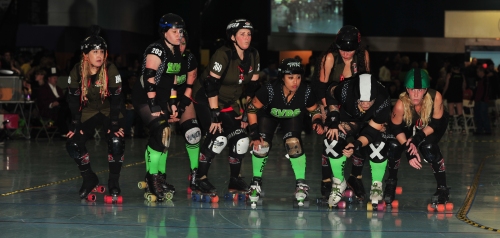
A KillaByte pack at the pivot line ready to start the jam. Note the two pivots on the right with the stripes on their helmets (that's Knuckles with the white stripe!)
pivot line–the starting line for the pack that is in front of the jammer line. Only the pivot is permitted to start on the pivot line; all other blockers must be lined up behind her hips. The pack may cross the pivot line once referee blows the first whistle to signal the start of the jam. If any skater crosses the line before the whistle, it is designated a false start.
positional blocking–using the body to obstruct another skater’s path rather than forcefully hitting her.
power jam–a situation wherein one team’s jammer has been sent to the penalty box, and thus only the team with a jammer on the track can score.
quads–skates with four wheels positioned two in front and two in back, contrasted with inline skates. Players cannot wear inline skates, only quads.
recycling–when a set of two or more blockers rotate in a circular motion, sending one blocker after another to issue continuous hits to an opponent. This is also known as a waterfall.
referee–or ref, also known as a zebra. An enforcer of the rules. Referees are dressed in black and white stripes and have whistles so that they can start and end jams and draw attention to penalties. Jam refs keep track of jammers, while pack refs (some inside the track boundary and some outside) keep track of the pack.
rink rash–a burn injury that occurs when flesh is dragged against a rink surface. Ouch!
roller derby–the awesomest sport ever.
scoring pass–any pass through the pack after the jammer‘s first pass (the nonscoring pass). At this time the jammer racks up points for each opponent she passes.
snowplow–a technique for slowing down or stopping in which the stance is widened and the toes are turned inward to decrease momentum.
star–the symbol on a helmet panty that indicates the jammer.
substitution–swapping players in between jams. Unlike other sports, no call needs to be made by a coach or ref; the skaters simply exchange places and leave/enter the track as needed.
t-stop–a technique for slowing down or stopping in which one skate is dropped behind the other skate and turned perpendicularly, and the wheels of the back skate are dragged.
taking a knee–if a skater is seriously injured on the track and the jam is called, it is common practice for skaters to drop to one knee while the injured skater is treated.
target zone–an area of the body which may be hit. Legal target zones include hands, arms, chest, abdomen, sides, hips, and the front and sides of the legs to the mid-thigh. Illegal target zones include the head, neck, back, butt, back of the thighs, and any part of the leg below mid-thigh.
three (3)–the blocker who plays the third position on the track.
toe guard–a device, usually leather or plastic, designed to protect the toe of the skate boot from damage.
toe stop–hardware for the skate that is plugged in to the plate beneath the toes. Often used for starts and stops.
track–the oval-shaped surface demarcated by an inner and outer boundary wherein the action takes place.
transition–the process of changing directions while skating from forwards to backwards or vice versa.
tripping–a major penalty in which one skater makes contact with another skater–intentional or not–in the no-contact zone below the knee, causing that skater to lose her balance and fall.
truck and trailer–when two teammates skate, one directly in front of the other, with the front (truck) pulling the back (trailer). Can be an effective method of getting a jammer through a pack.
turn–a curve in the track. Usually these are referred to numerically. The first turn past the pivot line is turn 1, the second is turn 2, etc.
turn stop–a stopping technique in which a skater reverses the direction she is skating (transitioning from forward to backwards) before stopping, usually by going up on her toe stops.

Knuckles wisely keeps her eye on the ref so she knows when she has reached 20 feet (note the ref's hand signal) and must let the jammer go.
twenty (20) feet–a referee call when a skater is out of the twenty-foot range of the pack and thus out of play. Blockers may not hit or assist and must immediately yield to opposing jammers upon reaching this point whether or not the call has been made by the ref. If they do not, they may earn an out of play penalty.
tw0 (2)–the blocker who plays the second position on the track. Often this blocker teams up with the pivot (1) to control the front of the pack.
wall–when two or more blockers skate side-by-side to create a multi-player block to contain another team’s player(s).
waterfall–when a set of two or more blockers rotate in a circular motion, sending one blocker after another to issue continuous hits to an opponent. This process is also known as recycling.
WFTDA—Women’s Flat Track Derby Association. This is a regulatory body that organizes leagues and establishes rules and rankings. SVRG plays by WFTDA rules and aspires to become a WFTDA-certified league.
whip–an assist technique wherein one skater uses another skater’s momentum to propel herself. For example, a jammer may grab a blocker’s arm, and the blocker will use her power and momentum to pull the jammer forward.
zebra–nickname for a referee.


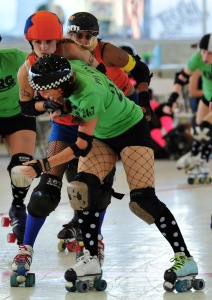
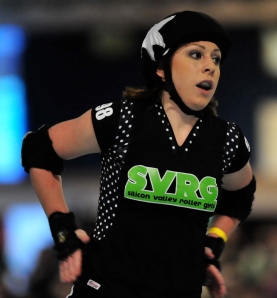







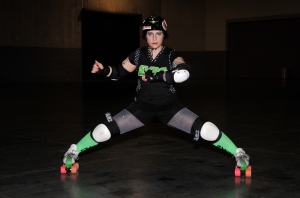
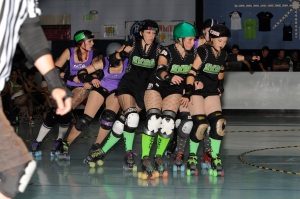
You must be logged in to post a comment.